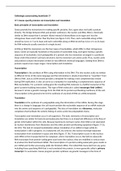Celbiologie samenvatting hoofdstuk 17
17.1 Genes specify proteins via transcription and translation
Basic principles of transcription and translation
Genes provide the instructions for making specific proteins. But a gene does not build a protein
directly. The bridge between DNA and protein synthesis is the nucleic acid RNA. RNA is chemically
similar to DNA except that it contains ribose instead of deoxyribose as its sugar and has the
nitrogenous base uracil rather than thymine (see figure 5.24). Thus, each nucleotide along a DNA
strand has A,G,C or T as its base and each nucleotide along an RNA strand has A,G,C or U as its base.
An RNA molecule usually consists of a single strand.
In DNA or RNA the monomers are the four types of nucleotides, which differ in their nitrogenous
bases. Genes are typically hundreds or thousands of nucleotides long, each gene having a specific
sequence of nucleotides. Each polypeptide of a protein also has monomers arranged in a particular
linear order (the protein’s primary structure), but its monomers are amino acids. Thus, nucleic acids
and proteins contain information written in two different chemical languages. Getting from DNA to
protein requires two major stages: transcription and translation.
Transcription
Transcription is the synthesis of RNA using information in the DNA. The two nucleic acids are written
in different forms of the same language and the information is simply transcribed or “rewritten” from
DNA to RNA. Just as a DNA strand provides a template for making a new complementary strand
during DNA replication, it also can serve as a template for assembling a complementary sequence of
RNA nucleotides. For a protein-coding gene the resulting RNA molecule is a faithful transcript of the
gene’s protein-building instructions. This type of RNA molecule is called messenger RNA (mRNA)
because it carries a genetic message from the DNA tot he protein-synthesizing machinery of the cell.
(Transcription is the general term fort he synthesis of any kind of RNA on a DNA template).
Translation
Translation is the synthesis of a polypeptide using the information of the mRNA. During this stage
there is a change in language: the cell must translate the nucleotide sequence of an mRNA molecule
into the amino acid sequence of a polypeptide. The sites of translation are ribosomes, molecular
complexes that facilitate the orderly linking of amino acids into polypeptide chains.
Transcription and translation occur in all organisms. The basic mechanics of transcription and
translation are similar for bacteria and eukaryotes but there is an important difference in the flow of
genetc information within the cells. Because bacteria do not have nuclei, their DNA is not seperated
by nuclear membranes from ribosomes and the other protein-synthesizing equipment (figure 17.3a,
blz 393). This lack of compartmentalization allows translation of an mRNA to begin while its
transcription is still in progress. In a eukaryotic cell, by contrast, the nuclear envelope separates
transcription from translation in space and time (figure 17.3b). Transcription occurs in the nucleus
and mRNA is then transported tot he cytoplasm, where translation occurs. But before eukaryotic
RNA transcripts from protein-coding gene scan leave the nucleus, they are modified in various ways
to produce the final functional mRNA. The transcription of a protein-coding eukaryotic gene results in
pre-mRNA and further processing yields the finished mRNA. The initial RNA transcript from any gene,
including those specifying RNA that is not translated into protein, is more generally called a primary
transcript. To summarize: Genes program protein synthesis via genetic messages in the form of
, messenger RNA. Put another way, cells are governed by a molecular chain of commandwith a
directional flow of genetic information.
The genetic code
Codons: triplets of nucleotides
Triplets of nucleotides bases are the smallest units of uniform length that can code for all the amino
acids. If each arragement of three consecutive nucleotide bases specifies an amino acid, there can be
64 (4^3) possible code words, more than enough to specify all the amino acids. Experiments have
verified that the flow of information from gene to protein is based on a triplet code: the genetic
instructions for a polypeptide chain are written in the DNA as a series of nonoverlapping, three-
nucleotide words. The series of words in a gene is transcribed into a complementary series of
nonoverlpping, three-nucleotide words in mRNA, which is then translated into a chain of amino acids
(figure 17.4).
During transcription, the gene determines the sequence of nucleotide bases along the length of the
RNA molecule that is being synthesized. For each gene, only one of the two DNA strands is
transcribed. This strand is called the template strand because it provides the pattern, or template,
for the sequence of nucleotides in an RNA transcript. For any given gene the same strand is used as
the template every time the gene is transcribed. For other genes on the same DNA molecule the
opposite strand may bet he one that always functions as the template.
During translation, the sequence of codons along an mRNA molecule is decoded, or translated, into a
sequence of amino acids making up a polypeptide chain. The codons are read by the translation
machinery in the 5’3’ direction along the mRNA. Each codon specifies which one of the 20 amino
acids will be incorporated at the corresponding position along a polypeptide. Because codons are
nucleotide triplets, the number of nucleotides making up a genetic message must be three times the
number of amino acids in the protein product. For example, it takes 300 nucleotides along an mRNA
stand to code fort he amino acids in a polypeptide that is 100 amino acids long.




